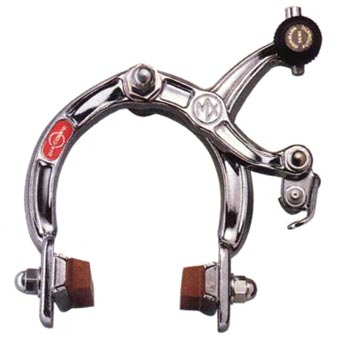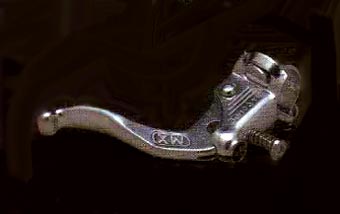

Dia Compe introduced the AD-990 brakes. Instead of the typical brake that had the cable threaded throuh the side of the brake, the 990 had the cable threaded through the center. This made it easier to keep the brake centered and allowed for greater braking power.
Mark Noble, Ride BMX UK september 2006: When Dia Compe launched the U-brake it was initially used on mountainbikes at the start of the eighties, prior to MTBs switching to the V-brake - and Haro were the first company to turn on to its far superior power compared to a standard calliper brake, and they placed U-brake lugs on their bikes way back in 1987. So, twenty years of use on a BMX bike has proven that the U-brake is the definitive stopping device for BMX. Two decades of solid braking... and yet, still we see bikes with haggered U-brakes that are about as effective and with as much stopping power as rubbing tissue paper on the tyre.
digbmx.mpora.com, september 2012: In the late 80’s Dia Compe, a Japanese company specialising in bicycle brakes, addressed the growing need for a stronger, freestyle orientated brake lever. The Tech 77 was an instant hit with riders, mainly due to its more rugged design and hinged clamp. Several versions of the Tech 77 Lever were released shortly after, most notably a version featuring the ‘Potts Mod’. This variation of the 77 featured a button, which when pressed would lock the brake in place. Riders like Rob Ridge used the assistance of the Potts Mod to pioneer insanely technical tricks like barspin abubacas on backrails, which weren’t possible with a standard lever. During the late 90’s it wasn’t uncommon to bend the blade of the lever with a spanner so that you could run it on the bend of the bar and cut down your handlebars to a narrower width, a trend out dated by today’s lack of brakes and ever growing bar widths. Dia Compe later released a version of the Tech 77 with a pre-bent blade, as many were bending it too much and snapping off from the lever entirely.
Dave Paterson, digbmx.mpora.com, september 2012: The Tech 77 is an example of product that has stood the test of time and hasn’t really aged since it was initially released. Despite the popularity of brakeless riding over the past decade, the lever is still available for purchase in bike shops around the world and is even spec’d on some 2013 complete bikes. To this day it remains the choice of stopping power for some of the biggest legends in BMX such as Chris Doyle and Van Homan.
Chris Doyle, digbmx.mpora.com, september 2012: When I think of the the Tech 77 lever, I always think of a picture I saw in an old BMX mag with 8 AA pro lined up on the starting gate. The rider’s bikes all had one thing in common, the Tech 77 brake lever. Each rider had a custom bend to the lever that was exclusive to them, and only them. Perhaps I was just young and impressionable, but I wanted to look just like the pros, so I went out and got my own, and of course, gave it a custom bend. I don’t know if the brake lever was/is well engineered, but it looked cool, and that was good enough for me. Fast forward to the present day, I still run it, custom bend, finger on at all times, trying to keep a little bit of MX in my BMX.
